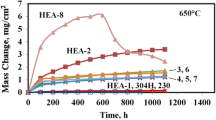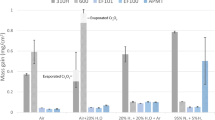Abstract
Twenty-five commercial nickel-, iron-, and cobalt-base sheet alloys incorporating chromium or chromium and aluminum additions for oxidation resistance were tested at 1150°C in air for 100 hr in both isothermal and 1-hr cyclic furnace exposures. The alloys were evaluated by sample specific weight change, by type of scale formed, by amount and type of spall, and by sample thickness change and microstructure. In isothermal steady-state oxidation, four types of controlling oxides were observed depending on alloy composition: NiO, Cr2O3-chromite spinel, ThO2-blocked Cr2O3, and αAl2O3-aluminate spinel. The latter three types are considered protective. In the Cr2O3-forming alloys, however, scale vaporization is a critical factor in determining the parabolic scaling rate based on paralinear oxidation. In cyclic oxidation the alloys which form Cr2O3-chromite spinel scales were degraded severely when sufficient chromite spinel developed to trigger spalling. The cyclic behavior of the other three types of alloys does not differ greatly from their isothermal behavior. If chromite spinel formation is minimal, the thinner the oxide formed, the less the tendency to spall. Factors contributing to a thin scale are low isothermal scaling rates; reactive element additions, such as thorium, lanthanum, and silicon; and scale vaporization. Scale vaporization may, however, lead to catastrophic oxidation at high gas velocities or low pressures or both. A tentative mass-balance approach to scale buildup, scale vaporization, and scale spalling was used to calculate the critical oxidation parameter—the effective metal thickness change. In general, this calculated thickness change agrees with the measured change to within a factor of 3 if a correction is made for grain boundary oxidation. The calculated thickness change parameter was used to rate the oxidation resistance of the various alloys under isothermal or cyclic conditions. The best alloys in cyclic furnace oxidation tests were either αAl2O3-aluminate spinel formers or Cr2O3 formers with ThO2 blockage.
Similar content being viewed by others
References
I. G. Wright, “Oxidation of Iron-, Nickel-, and Cobalt-Base Alloys,” Rep. MCIC-72-07, Battelle Columbus Labs. (AD-745473) (June 1972).
C. S. Tedmon, Jr., The effect of oxide volatilization on the oxidation kinetics of Cr and Fe-Cr alloys,J. Electrochem. Soc. 113(8), 766–768 (Aug. 1966).
C. S. Giggins and F. S. Pettit, The oxidation of TD-NiC (Ni-20Cr-2 vol. percent ThO2) between 900° and 1200°C,Metall. Trans. 2(4), 1071–1078 (Apr. 1971).
E. W. Haycock, Transitions from parabolic to linear kinetics in scaling of metals,J. Electrochem. Soc. 106(9), 771–775 (Sept. 1959).
D. Wajszel, A method for calculating paralinear constants for the formation of volatile scale,J. Electrochem. Soc. 110(6), 504–507 (June 1963).
H. Lewis, The kinetics of the oxidation process in nickel-chromium-base alloys,Metallurgia 83(495), 3–8 (Jan. 1971).
W. C. Hagel, Factors controlling the high-temperature oxidation of chromium,Trans. Am. Soc. Met. 56, 583–599 (1963).
G. W. Goward, Current research on the surface protection of superalloys for gas turbine engines,J. Met. 1–9 (Oct. 1970).
E. B. Evans, Oxidation of chromium and 80Ni-20Cr heater alloys,Corrosion 21(8), 274 (Aug. 1965).
C. E. Lowell, D. L. Deadmore, and S. J. Grisaffe, Oxidation of TD nickel at 1050° and 1200°C as compared to three grades of nickel of different purity,Oxid. Met. 4(2), 91–111 (1972).
C. E. Lowell and I. L. Drell, “Effect of Surface Preparation on Oxidation of WI-52 at 1800° and 2000°F (1255 and 1366 K),” NASA TN D-6148 (1971).
C. S. Giggins and F. S. Pettit, Oxidation of Ni-Cr-Al alloys between 1000° and 1200°C,J. Electrochem. Soc. 118(11), 1782–1790 (Nov. 1971).
R. F. Tylecote, The adherence of oxide films on metals,J. Iron Steel Inst., London 195, pt. 4, 380–385 (Aug. 1960).
G. C. Wood, High-temperature oxidation of alloys,Oxid. Met. 2(1), 11–57 (1970).
H. Pfeiffer. Reactions between high-temperature-resistant alloys and gases. Reactions between gases and solids,AGARD Conf. Proc., no. 52 (Feb. 1970).
F. W. Cole, J. B. Padden, and A. R. Spencer, “Oxidation Resistant Materials for Transpiration Cooled Gas Turbine Blades. I. Sheet Specimen Screening Tests,” NASA CR-930 (1968).
F. W. Cole, J. B. Padden, and A. R. Spencer, “Oxidation Resistant Materials for Transpiration Cooled Gas Turbine Blades. II. Wire Specimen Tests,” NASA CR-1184 (1968).
S. J. Grisaffe and C. E. Lowell, “Examination of Oxide Scales on Heat Resisting Alloys,” NASA TND-5019 (1969).
E. A. Gulbransen and K. F. Andrew, Oxidation studies in the nickel-chromium and nickel-chromium-aluminum heater alloys,J. Electrochem. Soc. 106(11), 941–948 (Nov. 1959).
B. Lustman, The intermittent oxidation of some nickel-chromium base alloys,Trans. Am. Inst. Min. Metall. Pet. Eng. 188, 995–996 (Aug. 1950).
J. W. Hickman and E. A. Gulbransen, An electron diffraction study of oxide films formed on nickel-chromium alloys,Trans. Am. Inst. Min. Metall. Pet. Eng. 180, 519–546 (1949).
R. G. Garlick and C. E. Lowell, “Alloy Composition Effects on Oxidation Products of VIA, B1900, 713C, and 738X—A High Temperature Diffractometer Study,” NASA TM X-2796(1973).
C. A. Barrett, G. J. Santoro, and C. E. Lowell, “Isothermal and Cyclic Oxidation at 1000° and 1100°C of Four Nickel-Base Alloys: NASA-TRW-VIA, B-1900, 713C and 738X,” NASA TND-7484 (1973).
C. S. Wukusik, “The Physical Metallurgy and Oxidation Behavior of Fe-Cr-Al-Y Alloys,” Rep. GEMP-414, General Electric Co. (June 1, 1966).
C. E. Lowell, “Cyclic and Isothermal Oxidation Behavior at 1100° and 1200°C of Nickel-20-Percent-Chromium, Nickel-20-Percent-Chromium-3-Percent-Manganese, Nickel-20-Percent-Chromium-3-Percent-Silicon, and Nickel-40-Percent-Chromium Alloys,” NASA TN D-7267 (1973).
G. C. Wood and J. Boustead, The influence of Group IIIA metals on the oxidation of Fe-Cr alloys,Corns. Sci. 8(9), 719–723 (1968).
W. A. Sanders and C. A. Barrett, “Oxidation Screening at 1204°C (2200°F) of Candidate Alloys for the Space Shuttle Thermal Protection System,” NASA TM X-67864 (1971).
J. K. Tien and F. S. Pettit. Mechanism of oxide adherence on Fe-25Cr-4Ar (Y or Sc) alloys,Metall. Trans. 3(6), 1587–1599 (June 1972).
C. H. Lund and H. J. Wagner, “Oxidation of Nickel and Cobalt-Base Superalloys,” DMIC Rep. 214, Battelle Memorial Inst. (Mar. 1, 1965).
Author information
Authors and Affiliations
Rights and permissions
About this article
Cite this article
Barrett, C.A., Lowell, C.E. Comparison of isothermal and cyclic oxidation behavior of twenty-five commercial sheet alloys at 1150°C. Oxid Met 9, 307–355 (1975). https://doi.org/10.1007/BF00613534
Received:
Issue Date:
DOI: https://doi.org/10.1007/BF00613534




